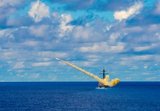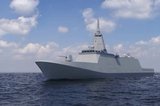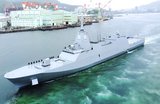Thales and FEBUS Optics unite to protect critical undersea infrastructure
Undersea cables and other critical undersea infrastructure need ongoing protection. (Image: Thales)
Thales and FEBUS Optics have signed a corporate strategic co-development agreement to protect and monitor critical undersea infrastructure via the development of new monitoring solutions. The deal follows in the wake of a recent joint international agreement between Germany and Norway.
FEBUS has long experience in developing distributed fibre optic sensing (DFOS) systems, and Thales is well-known for its sonar array design and acoustic signal analysis. The co-development agreement will see Thales use data from FEBUS’ high-performance distributed acoustic sensing (DAS) interrogator technology to devise an integrated solution that adds new functionality to Thales’ BlueGuard surveillance system.
The initiative will allow for consistent monitoring of the volume of water surrounding critical undersea infrastructure and acting effectively as a pressure-based tripwire, alerting operators if anything comes near the critical infrastructure that risks damaging or destroying it, whether that something is natural or malicious.
Related Articles
Anduril to use Dive-LD AUV in undersea infrastructure mission
Norway and Germany sign agreement on NATO undersea infrastructure
Since the Nord Stream event of 2022, which has never been conclusively explained but damaged a critical pipeline and forced up energy prices across Western Europe, protection of critical undersea infrastructure has become a thriving business sector.
Companies which already have significant undersea detection expertise have been among the first to capitalise on, and thrive within, this emerging sector, and Thales’ director of unmanned systems for underwater and seabed warfare, Marc Delorne, said the co-operative agreement would see the “combined expertise allow us to develop highly capable maritime surveillance solutions to protect and secure critical undersea infrastructure".
The co-development arrangement is expected to introduce FEBUS more fully to the maritime defence industry, and potentially to explore other uses for its specific expertise within the undersea defence sphere.
More from Naval Warfare
-
![NATO tests use of “undetectable, jam-proof” laser communication in maritime scenarios]()
NATO tests use of “undetectable, jam-proof” laser communication in maritime scenarios
As part of its effort to better prepare its capabilities for operations in contested and congested scenarios, NATO evaluated a Lithuanian ship-to-ship terminal designed to not be susceptible to enemy interference.
-
![Mitsubishi eyes future with Australia’s Mogami selection]()
Mitsubishi eyes future with Australia’s Mogami selection
With Australia’s selection of the Mogami-class for Project Sea 3000, Mitsubishi is investigating local production in the next decade as potential export opportunities emerge.
-
![Hanwha wins Australian government approval to increase its stake in Austal]()
Hanwha wins Australian government approval to increase its stake in Austal
The contract would mean the two shipbuilders can collaborate strategically and enhance shipbuilding capabilities in Western Australia.






















